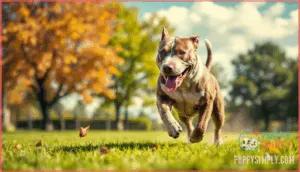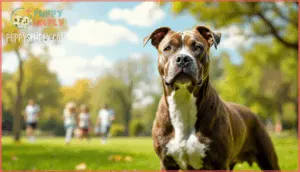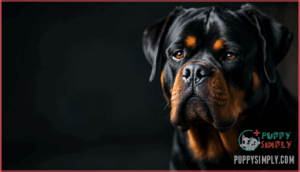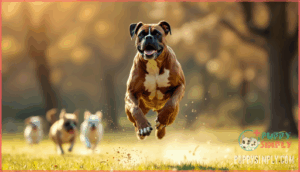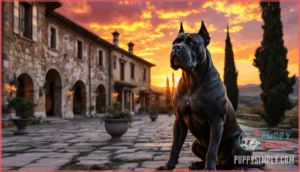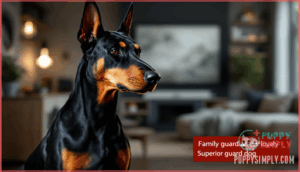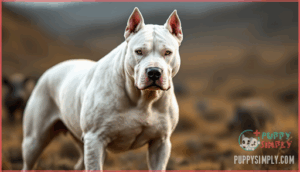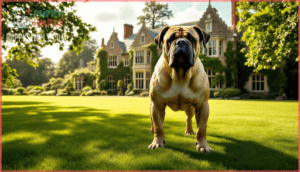This site is supported by our readers. We may earn a commission, at no cost to you, if you purchase through links.
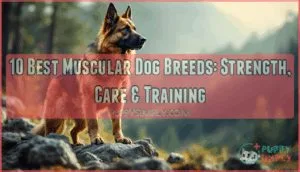
These dogs aren’t just heavy—they’re architectural marvels, with dense bone structures supporting rippling muscle beneath their coats. Whether you’re drawn to their commanding presence, need a working partner, or want a loyal protector, understanding what separates these powerhouses from average breeds helps you choose wisely.
The best muscular dog breeds combine physical prowess with trainable temperaments, but they require owners who respect their capabilities and commit to their demanding care needs.
Table Of Contents
- Key Takeaways
- What Defines a Muscular Dog Breed?
- Top Muscular Dog Breeds
- Muscular Breeds: Health and Exercise Needs
- Temperament and Training of Muscular Dogs
- Choosing The Right Muscular Dog Breed
- Frequently Asked Questions (FAQs)
- What health issues are common in muscular dog breeds?
- How can I find a responsible breeder of muscular dogs in my area?
- Are there any rescues that specialize in muscular dog breeds?
- Are muscular dog breeds good with other pets?
- What grooming needs do muscular breeds have?
- How much do muscular dog breeds typically cost?
- Can muscular breeds adapt to apartment living conditions?
- What age is best for adopting muscular breeds?
- Conclusion
Key Takeaways
- Muscular dog breeds carry 238 PSI bite force and centuries of selective breeding for strength, demanding owners who commit to 60-90 minutes of daily exercise and consistent training to channel their power appropriately.
- Genetic factors like myostatin mutations directly control muscle mass in breeds such as Pit Bulls, Rottweilers, and Dobermans, while proper nutrition requires 22-26% protein diets to maintain their impressive physiques.
- These powerhouses face serious health risks including hip dysplasia (affecting up to 77% of some breeds), dilated cardiomyopathy, and bloat, making regular veterinary screening and preventive care non-negotiable for longevity.
- Successful ownership hinges on matching breed intensity to your real lifestyle—experienced handlers see 68% success rates with proper socialization starting at 3-14 weeks, while first-time owners face 35% higher difficulty managing these dominant breeds.
What Defines a Muscular Dog Breed?
When you think of a muscular dog breed, what comes to mind? It’s not just about size or weight—these dogs have distinct physical traits, specific genetic backgrounds, and specialized roles that set them apart.
Let’s break down what truly makes a breed "muscular" and why these powerhouses have earned their reputation.
Key Physical Characteristics
When you’re looking at a truly muscular dog breed, you’ll notice some unmistakable features that set these powerhouses apart from their leaner counterparts. Their muscle mass is visible beneath the coat, creating defined contours across the chest, shoulders, and hindquarters.
These canine physiques are built on dense, heavy bone structures that support impressive strength. Breed standards specify particular size comparisons and coat variations, but the common thread? A solid, athletic build that commands respect.
Genetic Influences on Muscularity
You’re not just looking at selective breeding—you’re witnessing genetic polymorphisms at work. The myostatin mutation, found in breeds like whippets, directly impacts muscle mass by altering protein production. This muscle heritability explains why certain muscular dog breeds consistently produce offspring with remarkable canine physical attributes.
Genetic mutations like myostatin directly shape which dog breeds develop exceptional muscle mass through inherited traits
Fiber composition varies too—dog breed characteristics include different ratios of fast-twitch fibers that improve dog strength. Breed prevalence of these genes determines which lines dominate in athleticism and power.
Genes affecting traits like blood flow and heart rate also play a significant role.
Typical Roles and Uses for Muscular Breeds
These genetic advantages don’t just sit idle—they fuel the jobs these dogs were built to perform. Their power translates into real-world roles where strength meets purpose:
- Law enforcement and military applications rely on breeds like German Shepherds and Dobermans for suspect apprehension and patrol work
- Guard dog and protection duties leverage their protective instincts to secure properties and families
- Service dog roles including therapy animals utilize their physical capability combined with trainable temperaments
- Competitive sports like weight pulling and agility showcase working dog athleticism at peak performance
Top Muscular Dog Breeds
When you’re looking for a dog that turns heads with pure muscle and power, these ten breeds stand at the top. Each one brings something unique to the table, whether it’s the protective instincts of a guardian or the athletic drive of a working dog.
Let’s explore what makes each of these muscular breeds remarkable.
American Pit Bull Terrier
The American Pit Bull Terrier stands as a powerhouse among muscular dog breeds, packing 30 to 60 pounds of solid muscle onto a 17- to 21-inch frame. These athletes boast jaw strength around 242 PSI and dominate athletic achievements in weight-pulling competitions, hauling over 1,000 pounds. Breed recognition came in 1936, yet many still misunderstand their loyal nature.
Your Pit Bull’s activity levels demand 60–90 minutes of daily exercise for peak health and care. A similar breed, the Staffordshire Bull Terrier, benefits from a balanced diet and regular exercise to maintain its health.
American Staffordshire Terrier
You’ll love the American Staffordshire Terrier’s compact yet powerful build, weighing 40–70 pounds and standing around 18 inches tall. Breed recognition came in 1936, establishing this muscular dog breed’s place among elite athletes. Here’s what makes AmStaff temperament and care special:
- Exercise needs demand 60–90 minutes daily to maintain cardiovascular health
- Genetic health screening reveals 15% carrier frequency for metabolic disorders
- Training tips emphasize positive reinforcement for best dog training and socialization
- Dog breed health requires 22–26% dietary protein for muscle maintenance
These dog exercise requirements help your AmStaff stay powerful and healthy.
Rottweiler
Rottweilers are powerful dogs, weighing between 85 and 135 pounds, with males averaging 110 pounds. Historically, they were used for herding cattle and pulling carts in Germany, which contributed to their legendary strength. Today, their protective instincts make them excellent police dogs and family guardians. However, their confident and loyal temperament requires consistent training to prevent dominance issues.
To maintain their muscular frame, Rottweilers need a diet with 22–26% protein. Proper training is essential to manage their strength and temperament effectively.
| Rottweiler Attribute | Male Specification | Female Specification |
|---|---|---|
| Weight Range | 95–135 lbs (avg 110 lbs) | 85–115 lbs (avg 90 lbs) |
| Height at Shoulder | 24–27 inches | 22–25 inches |
| Max Pulling Strength | 2,000+ lbs documented | 1,500+ lbs documented |
| Daily Protein Needs | 600–700g muscle meat | 500–600g muscle meat |
| Exercise Requirements | 90+ minutes intensive | 90+ minutes intensive |
Rottweiler mixes often inherit the muscular traits of their parent breeds. However, health screening is crucial to prevent hip dysplasia, a common issue in this breed.
Boxer
Boxers blend explosive athleticism with a playful spirit that makes them standout companions for active families. These muscular dog breeds weigh 50–80 pounds and stand 21.5–25 inches tall, showcasing well-defined muscles built for agility and endurance.
Boxer history traces back to Germany, where they served as hunting and working dogs. Their exercise needs demand 60–90 minutes daily to maintain cardiovascular health and muscle tone.
Boxer temperament leans affectionate and energetic, though training tips emphasize early socialization to manage their enthusiastic nature. Dog breed characteristics include a lifespan of 10–12 years, with health concerns like cardiomyopathy requiring veterinary monitoring.
Cane Corso
Guard dog breeds demand respect, and the Cane Corso delivers raw power wrapped in loyalty. Weighing 90–120 pounds and standing 23.5–27.5 inches tall, this muscular dog breed showcases impressive skeletal development and a protective nature. Cane Corso breed history traces to ancient Rome, where they guarded estates and hunted game.
Cane Corso exercise needs include:
- 30-minute weighted walks for targeted muscle growth
- 10–15 hill climb repetitions to build endurance
- Drag sled work for hypertrophy development
- 500–600g daily protein intake for recovery
- Consistent training starting early for temperament management
Cane Corso temperament thrives with experienced owners who understand dog training fundamentals. Corso health issues require veterinary monitoring, while Corso training tips emphasize socialization to channel their guardian instincts appropriately.
Doberman Pinscher
When you combine elegance with raw power, you get the Doberman Pinscher—a muscular dog breed weighing 60–100 pounds and standing 24–28 inches tall. Breed standards emphasize their black and tan coat and lean, athletic build.
Guard dog breeds like this demand consistent dog training to cultivate protective instincts effectively. Doberman temperament balances alertness with loyalty, making them excellent family guardians.
Exercise needs include 60–90 minutes daily to maintain muscle tone. Health concerns involve dilated cardiomyopathy and hip dysplasia, requiring routine veterinary screening.
| Attribute | Details |
|---|---|
| Weight | 60–100 pounds |
| Height | 24–28 inches |
| Exercise | 60–90 minutes daily |
| Lifespan | 10–12 years |
| Guard Ability | Superior |
Dogo Argentino
Want a powerful breed with legendary hunting prowess? The Dogo Argentino stands 24–27 inches tall, weighing 80–100 pounds, with a bite force reaching 250–300 PSI. Their distinctive white skin pigmentation sets them apart among muscular dog breeds.
Breed origins trace to 1928 Argentina, where pack dynamics made them masters at hunting wild boar and puma. Dog breed characteristics include athletic endurance and protective instincts that require early, structured guidance.
Training challenges demand experienced owners who understand dog socialization and consistent dog training.
Bullmastiff
The Bullmastiff blends massive strength with surprising gentleness, weighing 100–130 pounds and standing 24–27 inches tall. Guard dogs by design, these muscular dog breeds were developed to patrol English estates and pin down intruders without mauling them.
Bullmastiff temperament leans calm and devoted, making family life rewarding when you establish clear boundaries early. Training challenges arise from their stubborn streak, so dog training requires patience and consistency.
Exercise needs stay moderate—daily walks and mental games prevent boredom. Health concerns include hip dysplasia and bloat, so regular vet checks matter.
Great Dane
While Bullmastiffs favor power over height, Great Danes rewrite the size chart entirely—muscular dog breeds standing 28–34 inches and weighing 110–175 pounds. These gentle giants combine imposing muscle with calm temperament traits, thriving as loyal companions despite size challenges.
Training needs focus on leash manners early, since managing a 150-pound adult tests even experienced owners.
Health concerns include bloat and heart disease, demanding vigilant dog health monitoring and a protein-rich diet to support their impressive frame.
Rhodesian Ridgeback
Rhodesian Ridgebacks are muscular dog breeds that balance lean strength with endurance, standing 24–27 inches and weighing 70–85 pounds. Their distinctive ridge along the spine reflects their hunting heritage, bred for tracking lions across African terrain.
Training needs emphasize consistency, as their independent instincts can challenge inexperienced owners. However, with proper socialization and regular exercise, they can excel in a family role.
- Ridge forms from reversed hair growth, a breed hallmark
- Originally developed in 1920s Rhodesia for big-game hunting
- Require 60+ minutes daily activity for muscle maintenance
- Dog breed characteristics include loyalty paired with strong prey drive
Muscular Breeds: Health and Exercise Needs
Owning a muscular dog breed means you’re taking on a powerful companion built for strength and endurance. These dogs need specific care to stay healthy, including the right balance of exercise, nutrition, and health monitoring.
Let’s break down what it takes to keep your muscular breed in peak condition.
Exercise Requirements for Muscle Maintenance
Keeping your muscular dog in peak condition takes more than just a few walks around the block—these powerhouse breeds need serious exercise to maintain their impressive physiques. Plan for 60-90 minutes of daily canine exercise, mixing activities like running, swimming, and strength-building games.
Ideal exercise variety prevents boredom and aids muscle recovery. Age considerations matter—puppies need gentler routines to avoid joint damage, while mature dogs benefit from consistent intensity for injury prevention.
Nutritional Considerations
Your muscular dog’s diet isn’t just about filling the bowl—it’s the foundation for maintaining that powerful build and keeping those well-developed muscles performing at their best.
A high-protein diet fuels muscle recovery and growth, with breed-specific diets adapted to your dog’s unique needs.
Don’t overlook supplement needs for joint support or hydration importance—proper dog nutrition means balancing protein intake with essential nutrients that keep your powerhouse performing like a champion.
Common Health Issues in Muscular Breeds
Despite their power, muscular breeds face distinct dog health challenges that demand vigilant dog care. Orthopedic problems like hip dysplasia affect up to 77% of some breeds, while cardiac concerns—especially dilated cardiomyopathy in Dobermans—strike roughly half the population after age four. Cancer risks, particularly osteosarcoma in Rottweilers, require early screening.
Skin conditions and musculotendinous injuries also threaten these athletes, making preventive dog diet and nutrition plus special care needs essential for maximizing dog breed health and lifespan.
Temperament and Training of Muscular Dogs
Muscular dogs bring raw power to the table, but that strength needs direction. Your ability to shape their conduct through proper training and socialization will determine whether you have a loyal protector or a liability on your hands.
Here’s what you need to know about managing the temperament of these powerful breeds.
Socialization Best Practices
Think of socialization like building a solid foundation for a house—without it, even the strongest structure can crack under pressure. Early socialization helps your muscular breed learn proper manners and navigate the world confidently. Start early exposure between 3-14 weeks for best results.
Here’s your socialization timeline:
- Weeks 3-7: Introduce gentle interaction, household sounds, and breed-specific needs assessment
- Weeks 8-12: Controlled meetups with vaccinated dogs using positive reinforcement
- Months 3-6: Expand to varied environments while addressing aggression signs immediately
- Ongoing: Continue dog training and socialization throughout their life for lasting confidence
Training Methods for Strong Breeds
Strong leadership starts with positive reinforcement—99.7% of owners use reward-based methods because they work. Consistency matters most; dogs trained with reliable routines learn commands 30% faster and show fewer problem actions.
Mental conditioning through puzzle toys and training sessions keeps powerful breeds focused. Breed challenges like high prey drive need professional guidance from certified behaviorists, who boost success rates by 35%.
Short, engaging dog training with high-value treats maximizes results.
Family Compatibility and Protective Instincts
The right muscular breed can be a devoted family guardian, but those protective instincts need careful guidance to keep everyone safe. Breed suitability varies—Boxers and Rottweilers thrive as family-friendly dog breeds with proper instinct management, while guard dogs need experienced supervision. Training impact determines whether guarding actions improve child safety or create risks.
Managing Protective Instincts:
- Early socialization prevents overprotective reactions to visitors and children’s friends
- Consistent boundaries teach your loyal companion when guarding is appropriate
- Supervision during play makes certain protective dog breeds don’t misinterpret rough games
- Professional training helps family pets balance alertness with a calm demeanor
Choosing The Right Muscular Dog Breed
Picking the right muscular breed isn’t about finding the toughest-looking dog—it’s about matching strength with your real-world situation. You’ll need to think about your daily routine, living space, and experience level before committing to one of these powerful companions.
Let’s break down the key factors that’ll help you make a smart choice.
Assessing Lifestyle Compatibility
Before bringing home a muscular dog breed, you’ll need to evaluate whether your daily routine can support their demands. First-time dog owners face 35% higher difficulties with these powerful breeds, while experienced caretakers see 68% success with dogs like Rottweilers and Bullmastiffs.
| Lifestyle Factor | What Your Dog Needs |
|---|---|
| Daily Time | 2–3 hours for training, exercise, and socialization |
| Owner Experience | Prior large-breed guidance strongly recommended |
| Family Dynamics | Best with children 10+ years; 74% positive outcomes |
| Activity Levels | 60–120 minutes vigorous exercise daily, 5+ days weekly |
Dog breed selection depends on an honest assessment of your commitment. Sedentary lifestyles increase behavioral issues by 40% in high-energy breeds. Your family pets thrive when breed suitability matches reality—not wishful thinking. Dog temperament reacts to consistency, and muscular dog breeds as companions require sustained dedication for proper dog exercise routines and socialization.
Space and Activity Needs
Once you’ve confirmed your lifestyle fits their energy, you’ll want to gauge whether your living space can accommodate a breed built like a linebacker. Apartment suitability drops 60% for muscular dog breeds without daily yard access. Your Rottweiler needs room for agility training and running—not just long walks.
Breed energy demands mental enrichment beyond physical exercise. Exercise intensity matters more than square footage, but cramped quarters increase stress-related actions by 45%. Exercise needs scale with your dog’s power.
Owner Experience and Handling Requirements
Managing a powerhouse breed isn’t like walking a golden retriever—you need confidence, consistency, and a willingness to learn their language before they learn yours. First-time owners often underestimate the commitment level these dogs demand. Experienced trainers understand that strong leadership through positive reinforcement during training sessions prevents dominance struggles. Breed-specific legislation may also limit ownership in certain areas.
What You’ll Need to Master:
- Daily Exercise Needs – 60-90 minutes of vigorous activity maintains muscle tone and mental balance
- Structured Dog Training – Weekly sessions build obedience and strengthen your trainer authority
- Lifestyle Adjustments – Your schedule revolves around their physical and mental stimulation requirements
- Legal Awareness – Research local breed restrictions before committing to breeds like Pit Bulls or Rottweilers
Frequently Asked Questions (FAQs)
What health issues are common in muscular dog breeds?
Powerful companions often face unique wellness challenges. Joint Problems and Hip Dysplasia frequently affect large, athletic dogs.
Heart Conditions and Bloat Risk require vigilant monitoring.
Cancer Rates can be elevated in certain breeds, making regular veterinary checkups essential for dog health and longevity.
How can I find a responsible breeder of muscular dogs in my area?
Finding responsible breeders starts with contacting national breed clubs for referrals, checking breeder reputation through veterinary recommendations, and visiting breeder facilities personally.
Verify health testing guarantees, assess their understanding of breed standards, and confirm ethical breeding practices including proper dog breed socialization and transparent dog breed health and lifespan information.
Are there any rescues that specialize in muscular dog breeds?
Yes, several breed-specific rescues focus on muscular dog breeds like Rottweilers, Dobermans, and Pit Bulls. These organizations offer rehabilitation programs, dog training, and dog socialization support.
Adoption challenges exist due to breed stigma, but fostering muscular breeds helps connect dogs with experienced owners through dedicated rescue resources.
Are muscular dog breeds good with other pets?
Muscular dog breeds can coexist with other pets, but breed-specific tendencies and early socialization impact success greatly.
Training consistency and supervision importance can’t be overstated when introducing pets—dog conduct hinges on proper guidance, making family pets harmonious.
What grooming needs do muscular breeds have?
Grooming requirements vary by coat types and shedding frequency. Short-haired breeds need weekly brushing, while regular bathing supports skin health.
You’ll manage nail trimming monthly and monitor for breed-specific issues affecting animal care and overall dog health and care.
How much do muscular dog breeds typically cost?
Initial purchase prices vary widely—from $800 to $3,000 depending on breed popularity and pedigree.
Maintenance costs include premium food, vet visits, and insurance implications.
Budget for hidden expenses like joint supplements and specialized training, essential for pet ownership success.
Can muscular breeds adapt to apartment living conditions?
Apartment living can work for certain muscular breeds if you prioritize their Exercise Needs and match Breed Temperament to your space.
Noise Levels, Apartment Rules, and Exercise Alternatives matter more than size alone when selecting Dog breeds for compact living.
What age is best for adopting muscular breeds?
Adopting younger dogs—like a puppy vs. an adult—brings distinct advantages. Puppies allow for early socialization and easier dog training, helping shape dog temperament and temperament changes from the start.
However, adult dog breeds often have established personalities, requiring less bonding time yet needing consistent socialization.
Health considerations matter at any age.
Conclusion
Ironically, the best muscular dog breeds don’t flex their strength to intimidate—they channel it into loyalty, work, and protection when it matters most. These powerhouses thrive under owners who respect their capabilities and meet their demands for exercise, training, and structure.
Choosing the right breed means matching their intensity to your lifestyle, not underestimating what they need to stay balanced. Get it right, and you’ll gain a partner whose physical prowess is only surpassed by their devotion.

